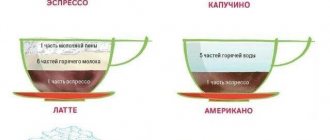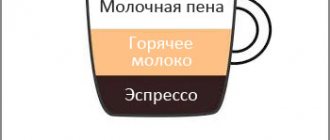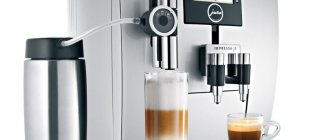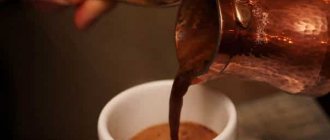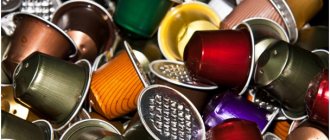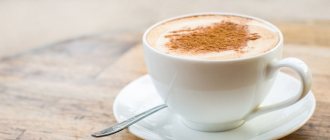Coffee is a popular drink served in all catering establishments. A professional barista chooses different Arabica varieties and additives to get an original taste. This is often how new menu items appear on popular food chains. Latte macchiato, which is in great demand today, was invented in a similar way.
General information about latte macchiato
More than 50 years have passed since the appearance of a new type of latte macchiato coffee, combining its classic bitterness and the tenderness of milk. Today it can be seen in almost all establishments serving drinks.
Origin story
Previously, it was not customary to drink brewed grains of the madder family plant with milk or other “softeners” of taste. Society did not accept such experiments until Italian cuisine became fashionable throughout Europe.
In the 19th century The British began to actively visit the Apennine Peninsula, where they took a different look at the drink made from roasted and ground grains from trees of the Rubiaceae family. Here it was customary to consume it with a small addition of milk. But the cappuccino was still too strong for tea lovers. Then the innkeepers tried to increase revenue, for which they began to soften the invigorating drink by adding more cream or milk. This was the first step towards the emergence of latte macchiato.
Classic coffee with milk is the progenitor of latte macchiato.
The delicate cocktail familiar to our contemporaries was invented later. It is impossible to say exactly who first decided to add coffee to milk, and not vice versa. There is a theory that the new recipe appeared even before the invention of special machines with cappuccino makers and automatic grinding of grains. Even today, latte macchiatos are made by hand, and coffee machines are used exclusively to prepare the base.
The new type of coffee gained fame in 1989, when it appeared on the menu of the Starbucks food service chain. Representatives of this brand assured consumers that the drink was made according to the traditional recipe of Italian innkeepers. But residents of the cocktail’s homeland still preferred the classic cappuccino.
The popularity turned out to be temporary: by the beginning of 2000, the recipe was forgotten again. This menu item was absent from coffee shops until 2016, when Starbucks decided to revive the once popular cocktail. By this point, the name “latte macchiato” meant nothing to marketers. The management of the coffee shop chain had to re-teach its employees to reproduce the traditional recipe of Italian innkeepers. Today, there is no need to explain how the new drink differs from Arabica or Robusta with whipped milk, even to those who drink nothing but tea.
Features and Properties
Latte macchiato is often confused with other cocktails that are similar in taste or appearance.
Although it is not difficult to distinguish it:
- It is prepared from the same ingredients as latte, but using a different technology. Coffee is added to milk, not the other way around.
- When serving a drink in a thick glass glass, it is easy to see the 3 layers. The foam forms a clear line, and the transition from coffee to milk looks like a neat gradient. The heterogeneity of the structure distinguishes the drink prepared according to a traditional Italian recipe from a latte. The shades depend on the selected Arabica variety.
- There is more milk than in cappuccino, so the coffee taste is less pronounced.
- No alcohol or cream is added to it.
Latte macchiato coffee has three layers and a heterogeneous structure.
Composition and calorie content
Arabica beans are always used for preparation. The second required ingredient is milk. Thanks to it, the calorie content of a macchiato is higher than that of an Americano. After drinking 1 serving, a person receives from 110 to 130 kcal of energy.
What is a macchiato
"Macchiato" is translated from Italian as "spotted". It is this characteristic spot on the airy foam of the drink that can be seen when serving a latte macchiato. It is formed during the preparation process, as a result of pouring a thin stream of hot espresso into already frothed milk.
Not a single Italian can imagine his existence without coffee. So that their children could also enjoy an aromatic coffee drink that would also be healthy, they came up with the macchiato. The reduced caffeine content makes it accessible and desirable for children.
Gradually, this cocktail became quite popular among adults. Today, its delicate milky coffee taste attracts a huge number of connoisseurs.
Drink recipes
The base is always a classic latte macchiato. Once cooking is complete, you can add syrup or other ingredients to enhance the flavor.
Classical
Pour milk preheated to approximately 60°C into a glass for Irish coffee and whip up the foam using a cappuccino maker. Then pour in the espresso in a thin stream. If done correctly, there will be foam at the top and the coffee will form a middle layer. Beginners may not always be able to reproduce the recipe exactly the first time, but a couple of tries is enough to learn how to form neat layers of coffee, milk and foam.
Caramel
To make a sweet cocktail, you will need 2 tsp. vanilla syrup. It is added to heated milk before whipping. Further preparation is carried out according to the recipe for a classic latte macchiato. The finishing touch is to decorate the foam with liquid caramel (about 4 tsp).
Latte macchiato with caramel.
With added syrup
You can use special additives. Thanks to syrups, coffee prepared according to a traditional Italian recipe acquires a fruity or berry flavor. For example, an original improvement to the recipe would be to add notes of blueberries or strawberries. To do this, just add 50 ml of the appropriate syrup, half of which should be poured into a glass, and the rest - into 150 ml of milk before whipping.
Latte macchiato can be prepared with various syrups: berry, fruit, etc.
Espresso macchiato
Arabica is used for preparation. 30 ml of espresso is brewed from it. Then whipped cold milk is poured into the base. If desired, you can add syrup, sugar, caramel or chocolate chips. You can decorate the drink, emphasizing its taste, with cinnamon or almonds.
Modern secrets of making this coffee
There are several ways to prepare a delicious macchiato.
Now baristas have many of their own recipes, the secrets of which are in no hurry to share. However, they all note that the main thing in a macchiato is the lush milk foam.
To achieve this, coffee is prepared from a mixture of two varieties of beans - Arabica and Robusta. It is important not to overdo it - the share of the latter should not be more than 15%, otherwise the drink will be bitter.
It is recommended to use 2.5–3.2% milk for a fluffy, stable foam, and for gourmets there is a recipe with baked milk or cream. To reveal the taste, professionals prepare macchiato using mineral water, since tap water has a chlorine taste.
Experiments with proportions and the addition of new ingredients have given coffee lovers several varieties of macchiato, the most famous of which are:
- Macchiato Fredo , cold milk is used to prepare it.
- Macchiato Caldo, with it the opposite is true - before frothing, the milk is heated, but not brought to a boil. Both of these recipes are classic and differ only in the temperature of the milk, but not in the proportions of the ingredients.
- Latte macchiato , its taste is more delicate due to the addition of more milk per standard serving of coffee.
- Caramel macchiato requires a little more time to prepare, since caramel syrup is initially prepared using water and sugar, then it is added in small portions to whipped milk along with espresso.
The price of a macchiato in our country starts at 150 rubles, but in popular coffee shops that use selected ingredients to prepare coffee, the cost of a serving of the drink is much higher.
For example, in the popular Starbucks chain, the cost varies from 280 to 450 rubles, depending on the volume.
Required ingredients for Latte Macchiato
Experienced baristas do not use Robusta beans to prepare latte macchiato - only 100% Arabica. Sometimes it is acceptable to make a mixture with excelsa to get a fruity flavor.
Arabica beans are used for latte macchiato coffee.
Professionals determine the degree of roasting by the color of the grain. When making a latte macchiato, it is important that the base is not strong. Therefore, it is recommended to choose a light roast - from cinnamon to Viennese.
If you need a big boost, you can make a strong base. City roasting is perfect for this. For a softer base, use light grains - cinnamon or New England. Grinding is chosen based on the method of preparing coffee. For example, espresso can be brewed in a Turk or any coffee maker.
The finished drink should not contain grounds. Therefore, when using a French press, filtering should not be neglected.
Milk selection
According to the traditional Italian recipe, the cocktail is never made using cream. But skim milk is not suitable either, because... You can’t get a fluffy foam from it. Therefore, the drink is prepared only using a cappuccino maker.
Sometimes it is acceptable to use a blender, but 3% or more fat milk must be heated (to no more than +65°C).
Caffeine Level
All three drinks contain the same amount of caffeine per serving.
For example, cappuccino and latte are made using a shot of espresso and thus contain the same amount of caffeine.
In fact, the average 475 ml cappuccino and latte contain about 173 mg of caffeine (, ).
Meanwhile, 60 ml of macchiato contains about half as much caffeine - just over 85 mg per serving ().
Summary:
Cappuccinos and lattes each contain 173 mg of caffeine per 475 ml serving, while a macchiato contains only 85 grams of caffeine per 60 ml serving.
Home cooking technology
The mild taste is easy to obtain without using a professional coffee machine. Since the base for a latte macchiato can even be brewed in a Turkish oven, reproducing the Starbucks signature recipe is easy. The cappuccino maker can be easily replaced with a blender. The main thing is that the fat content of the milk is high (more than 3%), otherwise the foam will not be fluffy enough. It is unacceptable to use cream, because... The consistency of the drink will be too thick.
Milk for making latte macchiato must have a fat content of more than 3%.
Coffee with a speck
Macchiato means "spotted" in Italian. Dark coffee stains appear on the white milk foam. The Italians, passionate about coffee, tried to make its taste more delicate and reduce the caffeine content. The name of the cocktail (“spotted milk”) indicates the main component.
The recipe was liked by those for whom strong coffee drinks are not recommended for health reasons. The impressive-looking drink in clear glasses began to be prepared and served in Starbucks coffee shops in 1989. It is especially loved by the fair sex in Europe for its delicate creamy taste and low calorie content.
Rules for serving and consumption
Since the cocktail appeared thanks to Italian innkeepers, it is customary to drink it according to their rules. You need to drink latte macchiato slowly, savoring the taste. It is unacceptable to swallow the entire glass in one gulp. Italians exclude added sugar, but are relaxed about chocolate chips. It is permissible to use syrup, but the drink should not become too sweet because of it.
Drinking latte macchiato is customary at the table. Drinking this cocktail at the bar is considered disrespectful to the work of the barista. Although the drink is usually served warm, you can get it hot. Just say “caffe bollente” to the waiter.
For serving, use a glass with a volume of 250-300 ml. The glass must be thick so that the latte macchiato remains warm.
Latte macchiato is consumed warm or hot while sitting at a table.
Sometimes the coffee cocktail is poured into cups. Experienced barista designers try to select dishes in warm pastel shades so that visitors can fully feel the comfort when drinking 3-layer Arabica coffee with milk. Less commonly, cups are replaced with mugs. The use of glasses is considered unacceptable.
Necessary components for preparation
You only need two ingredients: milk and coffee. Espresso is often prepared from Arabica beans or from a blend of Arabica and Robusta 80/20.
It's not just adults who drink the cocktail. Due to its low content, children are allowed to drink it. Therefore, sugar or syrup is appropriate in it. Any syrup you like can be used as a syrup. Cocoa and cinnamon are often used to decorate the top.
You can add cream to your coffee milkshake. Their combination with milk is also selected, but more often it is 1:1.
Fundamental differences from latte coffee
Today, almost everyone can recognize the cocktail. It differs in taste and appearance.
Visual difference
If a latte macchiato is served in a glass cup or glass, the gradient from milk to coffee is clearly visible through the walls. There is lush foam on top, making the drink look especially “warm”.
Differences in the selection of ingredients
Only Arabica beans are used to prepare this cocktail. Excelsa is less often added to give the aroma fruity notes. At the same time, expensive varieties are almost never used, because the taste of milk always dominates.
By production
The main difference between latte macchiato and other types of coffee is the order in which the cup is filled. Warm frothed milk is always poured in first, followed by espresso in a thin stream.
Coffee latte macchiato: first milk, then espresso.
Taste
The cocktail is considered the least strong of all coffee variations. Thanks to the large amount of milk, even the most picky coffee lovers will enjoy it.
Visual difference
In fact, a macchiato is a type of latte, despite the differences in preparation. The main difference is that the classic one is homogeneous in structure. Most of the glass is taken up by coffee with milk. The top is covered with airy white foam from the same milk. Visually, the drink consists of two layers, different in color and texture.
Interesting! Luwak coffee (kopi luwak) is the most expensive variety in the world made from animal excrement
Macchiato has more pronounced layers. There are three of them in total: the lower part of the glass is occupied by milk, then comes espresso and the top is covered with light and airy milk foam. The boundaries between layers are unclear. When the espresso is added they blur out a bit.
Although the proportions may differ in some countries, it is still a three-layer cocktail. Its characteristic feature and important difference is that very spot on the foam.
To prepare these two cocktails, it is not recommended to use expensive single-origin coffee, as their taste simply will not be felt. For macchiato, you should not use mixtures with a high content of robusta. It needs an emphasis on milky flavor rather than bitterness and strength.
Similar, but not the same
But this drink cannot be confused with anything. Firstly, when you mention mochaccino, the first thing that comes to mind is mocha coffee. But there is a 100% difference between these two concepts. So mochaccino is a drink, and mocha is a type of Arabica, which, by the way, can be used to make espresso, which can later become the basis for mochaccino.
Secondly, mochaccino is confused, or rather identified, with cappuccino. This is not mind-blowing, since in both the first and second cases the recipe includes coffee and milk. But mochaccino differs from cappuccino in its manufacturing technique, which in turn affects the taste of the finished product. So we can safely say that mochaccino differs from cappuccino, including in taste.
There is even a worldview that the mochaccino was first created in America, as a response to the Italian cappuccino, but this is only an assumption.
What is the difference between the process of making such similar, and at the same time such different coffees? First, the mochaccino contains, in addition to the usual set of espresso and hot milk, either chocolate syrup or chocolate in the form of cocoa powder. By the way, chocolate can be not only black, but also snow-white and milk (choose according to taste).
It is served in glasses with the highest walls made of heat-resistant glass. For decoration, you can take frothed milk, cream, cocoa and cinnamon. They really love combining mochaccino with marshmallows, although you need to be careful with this combination, because the caloric content of drinking increases with each new flavoring additive.
The method of making drink is more complex than in the case of cappuccino, because it also involves preparing chocolate:
- chocolate is crushed and poured with milk,
- Boil the milk-chocolate mixture over low heat until the chocolate is completely dissolved and foam appears on the milk,
- brew espresso and pour into a glass glass,
- A glass of milk with foam is poured onto the coffee and only then the chocolate prepared in advance is poured into it.
Even looking at the technology for creating the drink, the differences between these two coffees become clear.
As for the taste characteristics, mochaccino has a pronounced chocolate taste and, thanks to its complex multi-layer design, which looks great in transparent glasses, it can be classified as a dessert. Return to content
Mochaccino, cappuccino, latte: types and recipes for making coffee drinks.
Coffee is a drink that has been known for many years. It contains caffeine, which is great for energizing.
But not many people know that there are different types of coffee drinks. From time to time, when we come to a cafe and see a long list of types of coffee and coffee drinks, we simply get lost, not knowing what to choose. What is the difference between latte macchiato and mochaccino? What is the difference between South American coffee and cappuccino? In order to understand this, you should know what types of coffee drinks and coffee additives there are.
Americano and espresso - differences
Americano and espresso represent a group of coffees prepared in filter coffee makers or special coffee machines. The difference between these drinks is the caffeine concentration. Espresso is coffee containing a huge concentration of caffeine. Americano contains less caffeine than espresso. Americano is prepared in two ways. The first involves adding hot water to regular espresso, while the second, on the contrary, involves diluting the hot water with coffee. The correct proportion is one part espresso and 3 parts water. The volume of the finished drink should be 120 ml.
It is not possible to prepare espresso manually at home. Making real espresso involves forcing steam through ground coffee, which allows you to concentrate a huge concentration of caffeine in a small volume of water. You can make real coffee using special coffee machines, which, under a pressure of more than 9 bar, allow you to get a real tasty drink. Only with professional equipment can you get the right coffee. It is served in small thick-walled cups, which are also pre-heated. The light foam on the drink plays an extraordinary role. The color of the foam should be a warm nut color. The foam base should be dense.
Each of the presented drinks is different from each other, but they all have an unsurpassed taste and smell that will lift your tone for the whole day.
Cappuccino and mochaccino: the same espresso, milk, milk foam - but what is the difference?
The lack of coffee plantations did not in any way prevent the Italians from entering the history of the coffee industry as a country that:
- made espresso
- invented an espresso machine,
- introduced a new profession - barista,
- made a new kind of art - latte art,
- made our life sweeter and more enjoyable.
How else can you find out that it was the Italians who filled our boring everyday life with such delights as cappuccino, latte and mochaccino. So if Rome lost its own status as the capital of world fashion to Tokyo and New York, then the Italians will no longer give up their well-deserved regalia in the coffee industry to anyone. At least, as the inhabitants of this sunny country joke, “everything that could be invented from coffee has already been invented by our ancestors.”
How to make mochaccino?
We will add components:
- Whipped cream ,
- Hot chocolate,
- 100 ml milk,
- 2 tablespoons coffee,
- sugar and cinnamon to taste.
First, pour the hot chocolate into the glass in which we will serve our mochaccino. If you don’t have it ready, just melt the chocolate over the fire with a little milk.
Whisk the milk foam. Use the same principle as described above. Heat the milk in a saucepan and beat it with a mixer. When ready, pour into a glass of hot chocolate.
Brew espresso and add it as the final layer to our drink. Top with whipped cream and sprinkle with cinnamon or chocolate. This is one of the traditional mochaccino coffee recipes.
Recipes based on espresso macchiato
When people in different countries say “macchiato” they mean different drinks: latte macchiato, caramel macchiato and espresso macchiato. When placing an order, be sure to specify what drink you need. In Italy, the birthplace of the drink, there will be no misunderstandings: they will bring the classic macchiato. To prepare it, first pour coffee into a cup, and then milk foam. More coffee than milk.
The option with a predominance of coffee gives more room for imagination. Lovers of new tastes prepare various drinks based on the original recipe:
- Macchiato Fredo. In sultry Italy they like to add a little cold milk to hot espresso.
- Ristretto macchiato. This aromatic drink of minimal volume (15 ml) goes well with milk. For two servings of coffee (30 ml), take 10-15 ml of milk, using the same mixing method.
- Piccolo latte. “Little Milk” is prepared in the same way as a macchiato, but the portion is small: 30 ml of each ingredient.
- Cortado. According to the recipe, baked milk is used instead of regular milk. The taste is softer and creamier.
